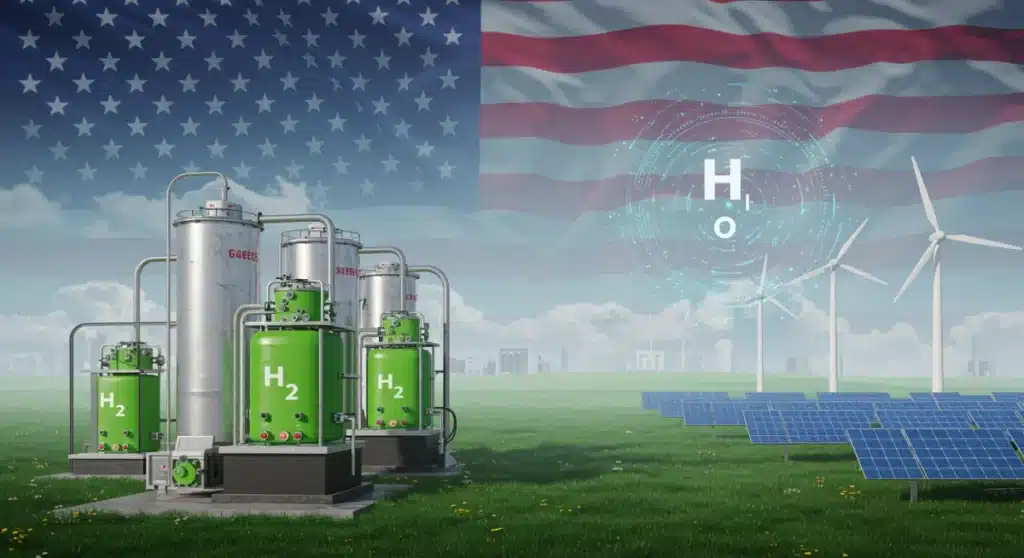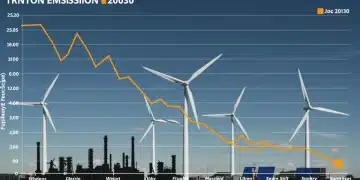Green Hydrogen: US Investment & 50% Cost Cut by 2030

U.S. green hydrogen investment is rapidly accelerating, with a projected 50% cost reduction by 2030, positioning the nation as a global leader in clean energy innovation and economic growth.
The Rise of Green Hydrogen: U.S. Investment Opportunities and a Projected 50% Cost Reduction by 2030 is rapidly gaining momentum, signaling a transformative era for clean energy. This pivotal shift, driven by significant policy support and technological advancements, is set to redefine America’s energy landscape.
U.S. Green Hydrogen Sector Sees Unprecedented Growth
The United States is currently experiencing an unprecedented surge in its green hydrogen sector. Recent developments indicate a robust commitment from both public and private entities to scale up production and deployment of this critical clean energy carrier. This growth is not merely aspirational; it is backed by substantial investment and strategic initiatives designed to accelerate its market penetration.
Analysts report that the U.S. is quickly becoming a global hub for green hydrogen innovation, attracting significant capital. The confluence of favorable policies, increasing demand for decarbonization, and advancements in electrolysis technology are creating fertile ground for new projects and expansions across the nation. This dynamic environment suggests a rapid evolution of the industry.
Key Drivers of Expansion
- Federal Incentives: The Inflation Reduction Act (IRA) offers generous tax credits, significantly lowering production costs for green hydrogen.
- Private Capital Influx: Major corporations and investment firms are pouring billions into hydrogen projects, recognizing its long-term potential.
- Technological Advancements: Continuous improvements in electrolyzer efficiency and renewable energy integration are making production more viable.
Projected 50% Cost Reduction by 2030: A Game Changer
One of the most compelling aspects of the current green hydrogen narrative is the projected 50% cost reduction by 2030. This aggressive forecast, widely cited by industry experts and government agencies, stands to be a monumental game changer for the energy sector. Such a decrease in production costs would make green hydrogen competitive with traditional fossil fuels, accelerating its adoption across various industries.
This anticipated cost reduction is primarily attributed to economies of scale in electrolyzer manufacturing, continued decreases in renewable electricity prices, and ongoing research and development. As production ramps up, the unit cost for electrolyzers is expected to drop significantly, much like what was observed with solar panels and batteries over the last decade. This makes green hydrogen investment increasingly attractive.

Factors Influencing Cost Decline
Several critical factors are converging to drive down the cost of green hydrogen. The continuous innovation in electrolyzer technology, leading to more efficient and cheaper units, is paramount. Furthermore, the declining cost of renewable energy sources, particularly solar and wind, directly impacts the primary input cost for green hydrogen production.
The development of large-scale production facilities also plays a crucial role. As projects scale up, they benefit from economies of scale, reducing capital expenditure per unit of hydrogen produced. Supply chain optimization and increased competition among manufacturers are also contributing to this downward trend, solidifying the economic viability of green hydrogen.
Significant U.S. Investment Opportunities Emerge
The burgeoning green hydrogen sector in the U.S. presents a wealth of investment opportunities across its entire value chain. From renewable energy generation to electrolyzer manufacturing, and from hydrogen transportation infrastructure to end-use applications, capital is flowing into diverse segments. This creates a dynamic environment for both established players and innovative startups.
Investors are eyeing opportunities in large-scale green hydrogen production hubs, particularly those strategically located near abundant renewable energy resources and industrial demand centers. Additionally, the development of pipelines, storage facilities, and refueling stations for hydrogen-powered vehicles represents another significant area for capital deployment. The federal government’s commitment to supporting these projects through various funding mechanisms further de-risks these investments.
Key Investment Areas
- Electrolyzer Manufacturing: Companies producing advanced electrolyzer technologies are seeing substantial interest.
- Renewable Energy Projects: Dedicated wind and solar farms for hydrogen production are essential.
- Infrastructure Development: Investments in pipelines, storage, and distribution networks are critical for market scaling.
- End-Use Applications: Developing and deploying hydrogen fuel cells for transportation, industrial processes, and power generation.
Policy and Regulatory Landscape Supporting Growth
The current policy and regulatory landscape in the U.S. is exceptionally supportive of green hydrogen development, providing a strong foundation for its growth. The Inflation Reduction Act (IRA) stands out as a landmark piece of legislation, offering production tax credits (PTCs) that can significantly offset the cost of green hydrogen, making it economically competitive.
Beyond the IRA, other federal programs and state-level initiatives are also contributing to this supportive environment. These include grants for research and development, loan guarantees for large-scale projects, and mandates for clean energy adoption. This comprehensive policy framework sends a clear signal to investors and developers that the U.S. is serious about fostering a robust hydrogen economy, driving further green hydrogen investment.
Impact of the Inflation Reduction Act
The IRA’s clean hydrogen production tax credit, offering up to $3 per kilogram for clean hydrogen, is a powerful incentive. This credit directly addresses the current cost differential between green hydrogen and its fossil fuel counterparts, effectively bridging the gap and accelerating market adoption. It is widely seen as the single most important policy driver for the U.S. green hydrogen sector.
Furthermore, the IRA includes provisions for clean manufacturing, tax credits for clean energy technologies, and investment in clean energy infrastructure, all of which indirectly benefit the green hydrogen ecosystem. This holistic approach ensures that the entire value chain receives support, fostering innovation and reducing risks for investors.
Challenges and Opportunities in Scaling Up Production
While the outlook for green hydrogen is overwhelmingly positive, the path to widespread adoption is not without its challenges. Scaling up production to meet projected demand requires significant technological advancements, infrastructure development, and skilled workforce training. Overcoming these hurdles will be crucial for realizing the full potential of green hydrogen.
One primary challenge lies in the sheer scale of renewable energy generation needed to power electrolyzers for green hydrogen production. Ensuring a consistent and affordable supply of renewable electricity is paramount. Additionally, the development of robust and safe hydrogen transportation and storage infrastructure is a complex undertaking, requiring substantial investment and regulatory coordination. However, these challenges also present significant opportunities for innovation and economic growth.
Addressing Infrastructure Needs
- Pipeline Development: Expanding and repurposing natural gas pipelines for hydrogen transport.
- Storage Solutions: Investing in underground cavern storage and advanced tank technologies.
- Refueling Networks: Building out a nationwide network of hydrogen refueling stations for transportation.
Global Implications and U.S. Leadership
The rapid advancement of green hydrogen in the U.S. has significant global implications, positioning the nation as a leader in the nascent hydrogen economy. As the U.S. scales up its production and deployment, it sets a precedent for other nations and contributes to global efforts to decarbonize heavy industries and transportation. This leadership role is not just about technology; it’s also about shaping international standards and fostering global collaboration.
The projected cost reductions in the U.S. could have a ripple effect worldwide, driving down global green hydrogen prices and making it more accessible to developing nations. This international impact underscores the importance of continued U.S. investment and innovation in the sector. The race to achieve net-zero emissions is a global one, and green hydrogen is emerging as a key player in this transition, with the U.S. at the forefront of its development.
The U.S. is actively engaging in international partnerships and initiatives to accelerate the global hydrogen economy. Sharing best practices, collaborating on research and development, and harmonizing regulatory frameworks are all part of this broader strategy. This proactive approach ensures that the benefits of green hydrogen extend beyond national borders, contributing to a more sustainable future for all.
| Key Point | Brief Description |
|---|---|
| U.S. Investment Surge | Significant public and private capital is flowing into the U.S. green hydrogen sector, driven by federal incentives and growing demand. |
| 50% Cost Reduction | Green hydrogen production costs are projected to decrease by 50% by 2030, making it competitive with fossil fuels. |
| Policy Support | The Inflation Reduction Act (IRA) offers substantial tax credits and incentives, bolstering green hydrogen development. |
| Scaling Challenges | Challenges include massive renewable energy needs and developing extensive hydrogen transportation infrastructure. |
Frequently Asked Questions About Green Hydrogen
Green hydrogen is produced through electrolysis, a process that uses renewable electricity to split water into hydrogen and oxygen. This method ensures zero greenhouse gas emissions during production, making it a truly clean energy source for various applications.
The U.S. is investing to decarbonize heavy industries, reduce reliance on fossil fuels, and achieve climate goals. Federal incentives like the Inflation Reduction Act make green hydrogen economically viable and attractive for domestic production and innovation.
The projected cost reduction stems from advancements in electrolyzer technology, economies of scale in manufacturing, declining renewable energy costs (solar/wind), and improved efficiency in the overall production process. Policy support further accelerates this trend.
Green hydrogen can be used in various sectors, including heavy-duty transportation (trucks, ships), industrial processes (steel, ammonia production), power generation and storage, and as a feedstock for chemicals. Its versatility makes it a key decarbonization tool.
Key challenges include scaling up renewable energy infrastructure, developing extensive hydrogen transportation and storage networks, and ensuring public acceptance. Overcoming these requires significant investment, technological innovation, and regulatory coordination across states.
Looking Ahead: The Future of U.S. Green Hydrogen
As the U.S. green hydrogen sector continues its upward trajectory, the coming years will be critical for solidifying its role in the national energy mix. We anticipate a rapid expansion of large-scale production hubs, further technological breakthroughs in electrolysis, and the accelerated development of crucial infrastructure. Watch for continued policy refinements and international collaborations that will shape the global hydrogen economy. The focus remains on translating ambitious projections into tangible, widespread deployment, ensuring a sustainable and decarbonized future.





